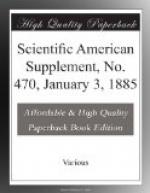The temperature was 100.2 deg.; the facial expression more natural; the tongue remained somewhat swollen and sore; she was no longer restless; she took tea, beef-tea, milk, etc., well; the functions of the secreting organs were being restored; she perspired freely; had micturated; the mucous membrane of the mouth was moist, and there was a tendency to tears without corresponding mental depression. The patient was ordered a mixture of ether and digitalis every four hours. On December 2 the pulse was 136, and the heart sounds reduplicated. The following day she was given bromide of potassium in place of the ether in the digitalis mixture. On the 4th the pulse was 126; reduplication gone. On the 6th the pulse was 82, and the temperature fell with the pulse rate. She was well enough to get into the ward for a few hours. Her memory, especially for recent events, was at that time greatly impaired. On the 12th she still complained of muscular pains like those of rheumatism. Apart from that, she was enjoying good bodily health.
A curious fact in connection with this case is that since this attempt at suicide she has steadily improved mentally, has lost her delusions, is cheerful, and employs herself usefully with her needle. She converses rationally, and tells me she recollects the impulse by which she was led to hang herself, and remembers the act of suspension; but from that time her memory is a blank, until two days subsequently, when her husband came to see her, and when she expressed great grief at having been guilty of such a deed. Her bodily health is now (June 30, 1884) more robust than formerly, and she is on the road to mental convalescence.
Remarks.—The successful issue of this case leads me to draw the following inferences: 1. That in cases of suspended animation similar to the above there is no symptom by which apparent can be distinguished from real death. 2. That in artificial respiration alone do we possess the means of restoring animation when life is apparently extinct from asphyxia, and that, with the tongue drawn well forward and retained there by the hand or an elastic band, the Silvester method is complete and effective. 3. That artificial respiration may be necessary for two hours or more before the restoration of adequate natural efforts, and that the performance of the movements ten times to the minute is amply sufficient, and produces a better result than a more rapid rate. 4. That galvanism, ammonia to the nostrils, cold affusion, and stimulants by the mouth are practically useless in the early stage. 5. That on the re-establishment of the reflex function we possess a powerful auxiliary agent in flagellation with wet towels, etc. 6. That centripetal surface frictions and the restoration of the body temperature by warm applications aid recovery. 7. That the heart, if free from organic disease, has great power of overcoming the distention of its right cavities and the obstruction to the pulmonary




